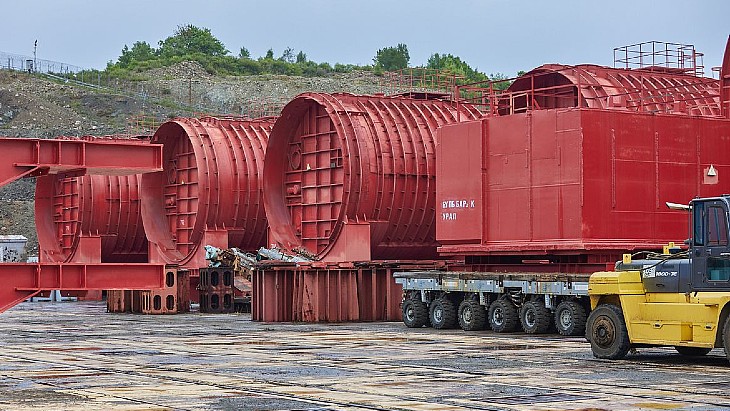Doors installed at Sellafield silo
 The Pile Fuel Cladding Silo at Sellafield is "a step closer to being cleaned up" thanks to the installation of six 12.4 tonne stainless steel doors designed to open the building's 'locked vaults'. The silo is one of the 'big four' legacy facilities at the Sellafield site in Cumbria, England.
The Pile Fuel Cladding Silo at Sellafield is "a step closer to being cleaned up" thanks to the installation of six 12.4 tonne stainless steel doors designed to open the building's 'locked vaults'. The silo is one of the 'big four' legacy facilities at the Sellafield site in Cumbria, England.The Pile Fuel Cladding Silo at Sellafield is "a step closer to being cleaned up" thanks to the installation of six 12.4 tonne stainless steel doors designed to open the building's 'locked vaults'. The silo is one of the 'big four' legacy facilities at the Sellafield site in Cumbria, England.
.jpg) |
| The six steel doors on the Pile Fuel Cladding Silo (Image: Sellafield Ltd) |
Sellafield Limited said the doors will be the access point for waste retrieval machinery to begin safely lifting out the silo's contents for the first time.
The first door safely arrived at the site in early August, following years of design, planning, manufacture and testing at the Rosyth site of supply chain partners Bechtel Cavendish Nuclear Solutions and BMT.
"One by one, the doors have been successfully lifted into a massive 40-tonne, nine-metre wide steel door frame on the side of the building. The doors will play a key role in reducing hazard at the site, enabling waste retrievals to start in 2020," Sellafield Ltd said.
Built between 1950 and 1951 the Pile Fuel Cladding Silo is 21m high and, inside, houses six extremely tall waste containers known as 'silos'. By the mid 1990s, the silo was nearing the end of its intended life. And, like any building exposed to the weather for 50 years, it required care and maintenance. A program of upgrade work was completed to enable the building to continue to store waste safely, prior to the next task in the program: to safely retrieve the waste and store it in compact concealed units. The Pile Fuel Cladding Silo has six compartments and now holds over 3200 cubic metres of intermediate-level waste.
Sellafield Ltd said in October that a complex remote cutting job was underway at the Pile Fuel Cladding Silo to enable the removal of cladding waste. Engineers used an innovative jet to remove plates of steel while maintaining an inert atmosphere important for safety.
The silo contains cladding materials removed from fuel assemblies used in some of the UK's earliest reactors at Windscale and Chapelcross. Irradiated cladding had to be removed before used fuel assemblies could be reprocessed to recover the uranium and plutonium they contained for the purposes of the joint power and weapons nuclear program run by the UK in the 1950s and 1960s.
Researched and written
by World Nuclear News
_17992.jpg)
_75800.jpg)







_66488.jpg)


